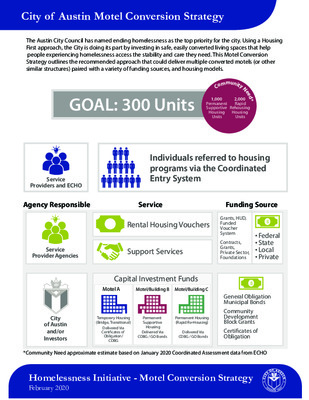2a_HSD_Motel Conversation Strategy_Feb20_v4-2 — original pdf
Backup

City of Austin Motel Conversion Strategy The Austin City Council has named ending homelessness as the top priority for the city. Using a Housing First approach, the City is doing its part by investing in safe, easily converted living spaces that help people experiencing homelessness access the stability and care they need. This Motel Conversion Strategy outlines the recommended approach that could deliver multiple converted motels (or other similar structures) paired with a variety of funding sources, and housing models. GOAL: 300 Units o m munity N C e e d * 1,000 Permanent Supportive Housing Units 2,000 Rapid Rehousing Housing Units Service Providers and ECHO Individuals referred to housing programs via the Coordinated Entry System Agency Responsible Service Funding Source $ Rental Housing Vouchers Service Provider Agencies Support Services Capital Investment Funds Motel A Motel/Building B Motel/Building C Grants, HUD, Funded Voucher System Contracts, Grants, Private Sector, Foundations $ Federal State Local Private $ General Obligation Municipal Bonds Community Development Block Grants Certificates of Obligation City of Austin and/or Investors Temporary Housing (Bridge, Transitional) Delivered Via Certificates of Obligation/ CDBG Permanent Supportive Housing Permanent Housing (Rapid Re-Housing) Delivered Via CDBG / GO Bonds Delivered Via CDBG / GO Bonds *Community Need approximate estimate based on January 2020 Coordinated Assessment data from ECHO Homelessness Initiative - Motel Conversion Strategy February 2020 City of Austin Motel Conversion Strategy Definitions COMMUNITY NEED Goal: 300 units achieved through the City of Austin’s Motel Conversion Strategy. Overall community need is 1,000 Permanent Supportive Housing units and 2,000 Rapid Re-housing units according to ECHO’s January 2020 Coordinated Assessment estimate. Population: Individuals and families who are chronically homeless and/or currently homeless and in need of housing solutions as identified through the Coordinated Entry System. Subpopulations include veterans, seniors, youth, victims of violence, individuals involved with the criminal justice system, and individuals with disabilities such as serious mental illness, substance use disorder, HIV/AIDS, and/or physical, intellectual or developmental disabilities.. COMMUNITY SOLUTIONS Permanent Supportive Housing (PSH) is an intervention that combines affordable housing assistance with voluntary support services to address the needs of chronically homeless people. The services are designed to build independent living and tenancy skills and connect people with community-based health care, treatment and employment services. PSH housing is targeted, deeply affordable (no more than 30% of household income required for rent, even for tenants with extremely limited or no income), lease-based, supported through services, and aligned with Housing First principles. Capital Funds: Public dollars available for acquiring the facility are supported through multiple funding sources, including different types of bonds (debt), grants and cash as well as other smaller sources of funding. Supportive Services: Case management, integrated healthcare, substance use treatment, employment, life skills, and tenant advocacy, available to the tenant on a voluntary basis with participation having no bearing on the lease. Rental Housing Voucher: Rental assistance such as a Housing Choice Voucher that serves as a permanent rental subsidy for housing stability over time. Rapid Re-housing (RRH) rapidly connects families and individuals experiencing homelessness to permanent housing through a tailored package of assistance that may include the use of time-limited financial assistance and targeted supportive services. The three core components of RRH include: 1) Housing Identification, 2) Rent and Move-In Assistance, 3) Rapid Re-Housing Case Management and Services. Housing First is an approach to quickly and successfully connect individuals and families experiencing homelessness to permanent housing without preconditions and barriers to entry, such as sobriety, treatment or service participation requirements. Supportive services are offered to maximize housing stability and prevent returns to homelessness as opposed to addressing predetermined treatment goals prior to permanent housing entry. Temporary Housing / Bridge Housing Model is temporary, transitional housing used as a short-term stay, often when an individual has been offered and accepted a permanent housing intervention, but access to that permanent housing is still being arranged. A variation of the model allows individuals to stay in a shared facility or apartment for up to several months for a small co-pay, depending on income, and receive housing-focused case management services to assist with transition to permanent housing. CDBG: Community Development Block Grant (federal funding) GO Bonds: General Obligation Bonds (local government funding) CO Bonds: Certificates of Obligation (local government funding) HUD: United States Department of Housing and Urban Development Homelessness Initiative - Motel Conversion Strategy For more information and definitions, please visit: austintexas.gov/homelessness February 2020